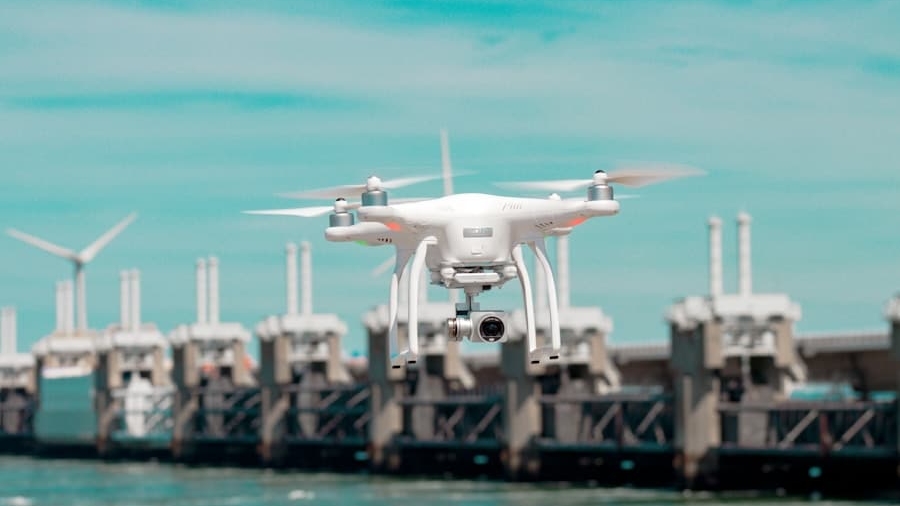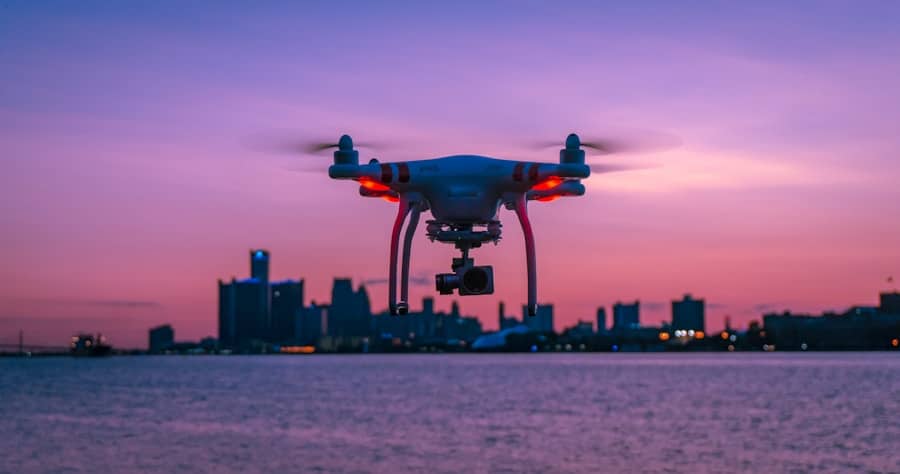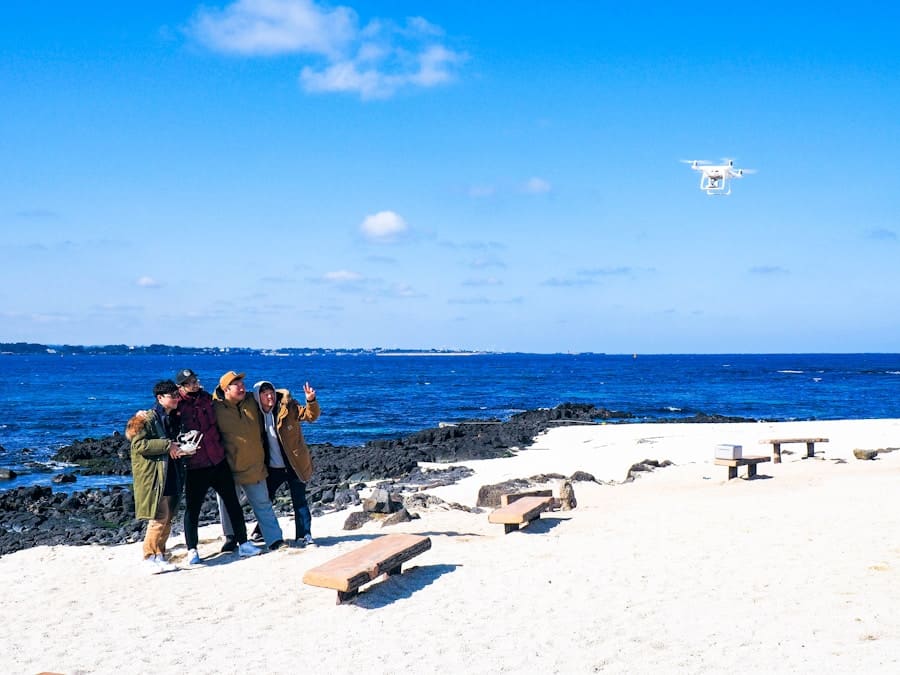The rapid proliferation of drone technology has ushered in a new era of aerial mobility, transforming industries ranging from logistics and agriculture to surveillance and emergency response. As the number of drones in the airspace continues to grow, the need for effective traffic coordination becomes increasingly critical. Dynamic drone traffic coordination refers to the real-time management of drone operations to ensure safety, efficiency, and compliance with regulatory frameworks.
This concept encompasses a range of technologies and methodologies designed to facilitate the seamless integration of drones into existing air traffic systems, thereby preventing collisions and optimizing flight paths. The advent of dynamic drone traffic coordination is not merely a response to the increasing number of unmanned aerial vehicles (UAVs) but also a proactive measure to harness their full potential. With applications such as package delivery, infrastructure inspection, and agricultural monitoring, drones are poised to revolutionize how we conduct business and manage resources.
However, the successful implementation of dynamic traffic coordination systems is essential to mitigate risks associated with drone operations, including airspace congestion and safety hazards. As we delve deeper into the challenges and solutions surrounding this topic, it becomes evident that advanced technologies, particularly artificial intelligence (AI), play a pivotal role in shaping the future of drone traffic management.
Key Takeaways
- Dynamic drone traffic coordination is a complex and evolving field that requires innovative solutions to ensure safe and efficient operations.
- Current challenges in drone traffic coordination include airspace congestion, collision avoidance, and integration with existing air traffic management systems.
- AI plays a crucial role in improving drone traffic coordination by enabling real-time decision making, predictive analytics, and autonomous navigation.
- Advancements in AI technology, such as machine learning and computer vision, are enhancing the capabilities of drones to navigate and communicate in dynamic environments.
- The potential benefits of AI in drone traffic coordination include increased safety, reduced operational costs, and the ability to scale drone operations for various industries.
Current Challenges in Drone Traffic Coordination
Despite the promising prospects of drone technology, several challenges hinder the effective coordination of drone traffic. One of the most pressing issues is the lack of standardized regulations governing drone operations across different jurisdictions. While some countries have established comprehensive frameworks for UAV usage, others are still grappling with the complexities of integrating drones into their airspace.
This regulatory patchwork creates confusion among operators and can lead to unsafe practices, as pilots may inadvertently violate airspace restrictions or fail to adhere to safety protocols. Another significant challenge is the limited communication infrastructure available for drones. Unlike manned aircraft, which rely on established air traffic control systems, many drones operate autonomously or semi-autonomously without real-time communication with other aircraft or ground control.
This lack of situational awareness can result in dangerous encounters between drones and manned aircraft or other UAVs. Furthermore, environmental factors such as weather conditions and geographical obstacles can complicate navigation and increase the risk of accidents. Addressing these challenges requires innovative solutions that enhance communication, improve regulatory compliance, and ensure safe operations in increasingly crowded airspaces.
The Role of AI in Improving Drone Traffic Coordination
Artificial intelligence has emerged as a transformative force in various sectors, and its application in drone traffic coordination is no exception. AI technologies can analyze vast amounts of data in real-time, enabling drones to make informed decisions based on their surroundings. For instance, machine learning algorithms can process information from sensors and cameras onboard drones to identify obstacles, assess flight paths, and predict potential collisions.
This capability allows drones to autonomously adjust their routes or altitudes to avoid hazards, significantly enhancing safety. Moreover, AI can facilitate better communication between drones and ground control systems. By employing natural language processing and machine learning techniques, AI can interpret commands from operators and relay critical information about airspace conditions back to them.
This two-way communication streamlines operations and ensures that all parties involved have access to up-to-date information regarding drone movements and potential risks. As a result, AI not only improves individual drone performance but also contributes to a more cohesive and efficient air traffic management system.
Advancements in AI Technology for Dynamic Drone Traffic Coordination
Recent advancements in AI technology have paved the way for more sophisticated dynamic drone traffic coordination systems. One notable development is the use of computer vision algorithms that enable drones to perceive their environment in real-time. These algorithms can detect and classify objects within a drone’s vicinity, allowing it to navigate complex environments safely.
For example, a delivery drone equipped with computer vision can identify pedestrians, vehicles, and other obstacles while en route to its destination, adjusting its flight path accordingly. Additionally, advancements in reinforcement learning have empowered drones to optimize their flight strategies based on past experiences. By simulating various scenarios and learning from outcomes, drones can develop more efficient routes that minimize travel time while avoiding congested areas or hazardous conditions.
This capability is particularly valuable in urban environments where multiple drones may be operating simultaneously. The ability to learn from real-world data enhances the adaptability of drone operations, making them more resilient to changing conditions.
Potential Benefits of AI in Drone Traffic Coordination
The integration of AI into drone traffic coordination offers numerous benefits that extend beyond mere safety enhancements. One significant advantage is increased operational efficiency. By leveraging AI algorithms to optimize flight paths and reduce delays, drone operators can improve delivery times and reduce fuel consumption.
For instance, logistics companies utilizing AI-driven traffic coordination can ensure that their delivery drones take the most efficient routes, resulting in cost savings and improved customer satisfaction. Furthermore, AI can enhance scalability in drone operations. As demand for drone services grows, traditional traffic management systems may struggle to accommodate the influx of UAVs.
However, AI-powered solutions can dynamically adjust to changing conditions and manage larger fleets of drones without compromising safety or efficiency. This scalability is particularly crucial for industries such as e-commerce and agriculture, where the ability to deploy multiple drones simultaneously can significantly impact productivity.
Ethical and Legal Considerations in AI-Driven Drone Traffic Coordination
Privacy Concerns
Drones equipped with cameras and sensors can inadvertently capture sensitive information about individuals or properties during their operations. As such, regulations must be established to govern data collection practices and ensure that operators respect individuals’ privacy rights.
Accountability in Decision-Making
Accountability becomes a critical issue when AI systems are involved in decision-making processes. In the event of an accident or incident involving a drone, determining liability can be complex if an AI algorithm was responsible for the actions taken by the UAV.
Evolving Legal Frameworks
Legal frameworks must evolve to address these challenges by clarifying the responsibilities of operators, manufacturers, and software developers in cases where AI-driven systems are implicated in accidents.
Future Applications and Implications of AI in Drone Traffic Coordination
Looking ahead, the future applications of AI in dynamic drone traffic coordination are vast and varied. One promising area is urban air mobility (UAM), where drones could serve as airborne taxis or delivery vehicles within densely populated cities. As urban areas continue to grapple with congestion and pollution, integrating drones into public transportation systems could provide a sustainable alternative for short-distance travel.
AI will play a crucial role in managing these operations by ensuring safe takeoffs and landings while coordinating multiple drones within limited airspace. Moreover, AI-driven drone traffic coordination could extend beyond urban environments into rural areas for agricultural applications. Drones equipped with advanced sensors can monitor crop health, assess soil conditions, and even assist with planting or harvesting tasks.
By coordinating multiple agricultural drones through AI systems, farmers can optimize their operations for maximum yield while minimizing resource usage.
The Path Forward for AI in Dynamic Drone Traffic Coordination
As we navigate the complexities of integrating drones into our airspace, it is clear that dynamic traffic coordination will be essential for realizing their full potential. The challenges posed by regulatory inconsistencies, communication limitations, and safety concerns necessitate innovative solutions that leverage advanced technologies like artificial intelligence. By harnessing AI’s capabilities for real-time data analysis, decision-making, and communication enhancement, we can create a safer and more efficient environment for drone operations.
The path forward involves not only technological advancements but also thoughtful consideration of ethical and legal implications associated with AI-driven systems. As stakeholders from various sectors collaborate to establish standards and regulations governing drone operations, it is imperative that we prioritize safety while fostering innovation.
In a recent article discussing the future of AI in dynamic drone traffic coordination, it is important to consider the advancements in technology that will shape the way drones interact with each other and their surroundings. For those interested in staying up to date with the latest tech trends, an article on com/how-to-choose-the-right-iphone-for-you-in-2023/’>how to choose the right iPhone for you in 2023 may provide valuable insights into the latest smartphone features.
Additionally, understanding different HTML styles, as discussed in this article, can help developers create visually appealing interfaces for drone traffic coordination software. Furthermore, freight forwarders looking to optimize their operations may benefit from exploring the best software for freight forwarders in 2023 to streamline their processes and improve efficiency.
FAQs
What is AI in dynamic drone traffic coordination?
AI in dynamic drone traffic coordination refers to the use of artificial intelligence to manage and optimize the movement of drones in a dynamic and complex environment. This involves using AI algorithms to make real-time decisions about drone routes, speed, and coordination to ensure safe and efficient traffic flow.
How does AI contribute to dynamic drone traffic coordination?
AI contributes to dynamic drone traffic coordination by enabling drones to make autonomous decisions based on real-time data and environmental factors. AI algorithms can analyze and predict traffic patterns, weather conditions, and other variables to optimize drone routes and avoid collisions.
What are the benefits of using AI in dynamic drone traffic coordination?
The benefits of using AI in dynamic drone traffic coordination include improved safety, increased efficiency, and reduced operational costs. AI can help drones navigate complex airspace, avoid collisions, and adapt to changing conditions, leading to more reliable and effective drone operations.
What are the challenges of implementing AI in dynamic drone traffic coordination?
Challenges of implementing AI in dynamic drone traffic coordination include the need for robust and reliable data sources, the development of advanced AI algorithms, and regulatory considerations. Additionally, ensuring the security and privacy of the data used by AI systems is a critical challenge.
What is the future outlook for AI in dynamic drone traffic coordination?
The future outlook for AI in dynamic drone traffic coordination is promising, with continued advancements in AI technology and the increasing integration of drones into various industries. As AI capabilities improve, drones will be able to operate more autonomously and efficiently, leading to widespread adoption in areas such as delivery services, infrastructure inspection, and emergency response.



